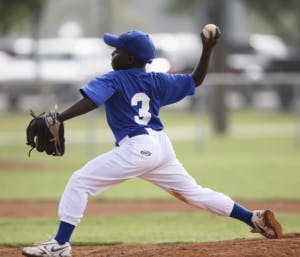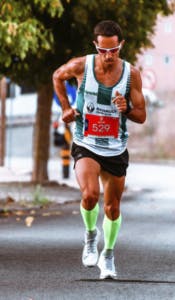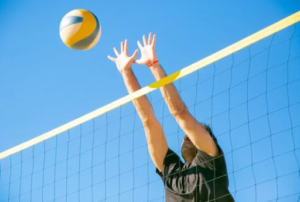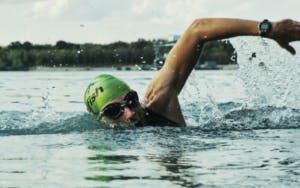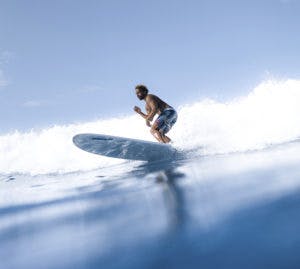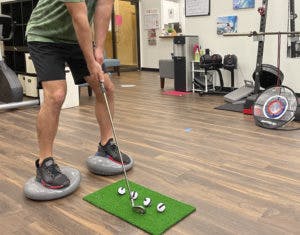A recent analysis of consumer injury data shockingly discovered that at-home workout injuries increased 48% from 2019 to 2020. Some of the increase is due to more people working out at home during the pandemic when gyms and group exercise classes were put on hold. However, roughly 30% of all at-home exercise injuries occurred in people aged 60 or over. The equipment most likely to cause injuries were treadmills and exercise bikes.
In our OrthoSport Hawaii clinics, we’ve seen an increase in patients coming to therapy for orthopedic injuries and pain syndromes. There are a few predominant pandemic-related themes:

Someone who used to exercise pre-pandemic, completely stopped working out. Their gym, yoga studio, pool, etc. was closed. They may have spent a great deal of time at home, watching NetFlix. Now they are suffering from deconditioning, poor posture, weight gain, and so on. This has led to insidious neck, back, shoulder, knee, wrist, or foot pain.
Someone who used to exercise pre-pandemic suddenly getting back to their previous exercise routines. They are launching themselves with great gusto into Zumba, tennis, running, basketball, bodybuilding, jujutsu, etc. Due to poor conditioning, decreased strength and/or flexibility they are injuring themselves pretty quickly.
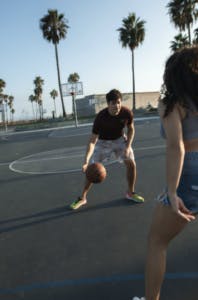 In addition we’ve seen a great number of office workers with pain from working in less than ergonomic conditions, especially those working from home on laptops or with poor home office setups.
In addition we’ve seen a great number of office workers with pain from working in less than ergonomic conditions, especially those working from home on laptops or with poor home office setups.
Did you pick up a new sport during the lockdowns? We’ve been seeing more newbie surfers, joggers, cyclists, and others in more socially distant sports. Along with new sports have come new injuries. With fewer family and social engagements to attend, some folks have found themselves engaging in novel activities at a much greater frequency than they would have normally.
All of these factors have created a boom in new patients visiting our clinics. This is great for business but not so great for the public, so let’s see if we can help. If you haven’t read our series on returning to fitness activities, start with Returning to Exercise After a Layoff.
Why are there more injuries in people over 60?
– Older bodies, regardless of fitness level, require longer warm-ups and cool-downs than they did in their younger years. As we age, connective tissue naturally loses its elasticity. If you have wrinkles on the outside, similar processes are occurring on the inside, you just can’t see them. Less elasticity means tissue is more likely to tear.
– Our maximum heart rate lowers as we age. This is not related to cardiovascular fitness. A 60 year old can be much fitter than a 30 year old, but no matter what, their 60 year old heart simply can’t beat as fast. That’s why having a strong heart is so important as we get older. A stronger heart doesn’t need to beat so fast as it can pump more blood with each beat. A simple formula for estimating your maximum heart rate is 220-your age. Therefore a 30 year old’s heart can beat all out at 190 bpm. A 60 year old’s can only reach 160 bpm. This affects how much work the body can perform. 
– Many in-home workout programs, online fitness classes, etc are designed by and geared for a younger audience. The exercises may not be as appropriate for someone with stiffer joints, old injuries, asthma, or other medical conditions.
Why are there more injuries with home gym equipment?
– The treadmills, ellipticals and exercise bikes found at your local gym are probably heavy-duty, high quality machines designed to be used for hours and hours every day. For home use, consumers usually purchase something less expensive and therefore of a lower quality. This may be perfectly fine but could potentially have more defects or breakdowns of the equipment.
– Many people use exercise equipment incorrectly. They may set the treadmill speed too fast, or place it in a location that could cause injury, such as next to a wall. Weight benches may need to be assembled and one missing piece could spell disaster when barbells and plates are added. If you are putting your road bike on a trainer, be careful as you can fall off that thing!
– Home exercisers often use their home equipment inconsistently. Without a plan or program it’s easy to slack off and lose focus. Just because you were able to lift 50 lbs over your head three weeks ago doesn’t mean you can do that again today.
So if the gym is closed or open for too few hours, if it’s too crowded or your favorite classes are cancelled what can you do? Working out at home is a great option for many but it may be wise to consult with a fitness expert when deciding on equipment, exercise programming, pacing, and goal setting.
How OrthoSport Hawaii Can Help
We offer a free, no obligation, one-hour fitness orientation to help you understand what you will need to reach your fitness goals. These sessions are offered in our Downtown and Niu Valley locations. Once we’ve established where you are and where you want to go, we offer in-person and online personal training as well as online group exercise classes.
We can also consult with you online about equipment setup, exercise progressions and planning, home safety, etc to get you ready for your home workouts. Call for information on pricing for this consulting service. 
Having pain or dealing with an old injury? Our PTs can consult with you in-clinic, or online to see if physical therapy may be the first step prior to a home exercise program. Our 30-minute, no-charge consultations are scheduled same-day by calling 808.373.3555.
Suffering the effects of overdoing it? Our massage therapists are ready to schedule 30, 60, and 90-minute appointments in our Downtown and Niu Valley clinics.
Not sure where to start? Call our Medical Fitness Center at 808.373.1114 for information on the appropriate services to meet your needs.
Remember the key to success is planning, consistency, progression and feedback. Our medical fitness experts are ready to share their knowledge and experience with you. Call today!
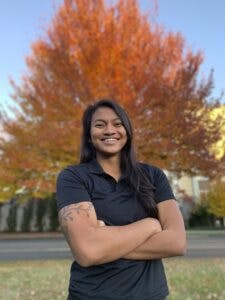 Aloha! My name is Mariah. I used to work briefly at the downtown location a couple years ago & I’m beyond grateful to be back working at OrthoSport at the Niu Valley location! I’m a certified personal trainer and corrective exercise specialist. I was born and raised on the west side of the island. I played collegiate soccer at Graceland University, where I studied Psychology and Corrective Exercise & Performance Enhancement.
Aloha! My name is Mariah. I used to work briefly at the downtown location a couple years ago & I’m beyond grateful to be back working at OrthoSport at the Niu Valley location! I’m a certified personal trainer and corrective exercise specialist. I was born and raised on the west side of the island. I played collegiate soccer at Graceland University, where I studied Psychology and Corrective Exercise & Performance Enhancement.



 Don’t let stress, fitness, or health issues keep you from your goals. Call 808.373.1114 for information on medical gym and massage therapy services in our Downtown and Niu Valley clinics. Call 808.373.3555 for information on physical therapy services in our Downtown, Niu Valley, and Kaka’ako locations.
Don’t let stress, fitness, or health issues keep you from your goals. Call 808.373.1114 for information on medical gym and massage therapy services in our Downtown and Niu Valley clinics. Call 808.373.3555 for information on physical therapy services in our Downtown, Niu Valley, and Kaka’ako locations. Through CrossFit I learned about powerlifting, bodybuilding, gymnastics, Olympic weightlifting, calisthenics, speed and agility, endurance, HIIT training, and mobility. All the strength and knowledge I gained from training I wanted to share and have others experience the same as well. My goal is to help others take control of their lives by training and realize their bodies true potential or just to help maintain normal function and independence.
Through CrossFit I learned about powerlifting, bodybuilding, gymnastics, Olympic weightlifting, calisthenics, speed and agility, endurance, HIIT training, and mobility. All the strength and knowledge I gained from training I wanted to share and have others experience the same as well. My goal is to help others take control of their lives by training and realize their bodies true potential or just to help maintain normal function and independence.

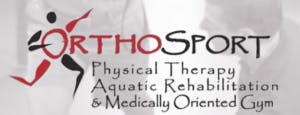
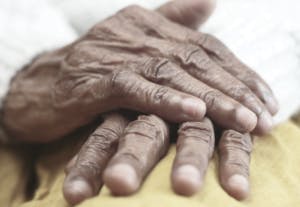
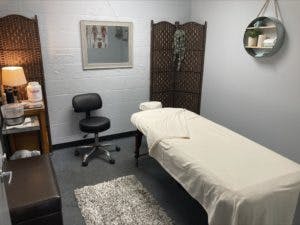


 Derrick wakes up after a night of restless sleep and is running late for work. He decides to put some extra sugar in his coffee and grabs a cinnamon roll on his way out the door. Forty-five minutes later he is sitting at his desk feeling exhausted and ready to go home although his day has barely started. Eating that cinnamon roll and the extra sugar has inhibited the growth of “good” bacteria in his gut which negatively affects neurotransmitter production. This essentially slows down the messaging of important chemicals (i.e. GABA, serotonin, norepinephrine, dopamine, acetylcholine, melatonin) from his gut to his brain. He decides on a second cup of coffee with more sugar to perk him up and for a while it does, as his blood glucose levels spike, but it’s short-lived and followed by a second wave of crashing as his blood glucose levels plummet.
Derrick wakes up after a night of restless sleep and is running late for work. He decides to put some extra sugar in his coffee and grabs a cinnamon roll on his way out the door. Forty-five minutes later he is sitting at his desk feeling exhausted and ready to go home although his day has barely started. Eating that cinnamon roll and the extra sugar has inhibited the growth of “good” bacteria in his gut which negatively affects neurotransmitter production. This essentially slows down the messaging of important chemicals (i.e. GABA, serotonin, norepinephrine, dopamine, acetylcholine, melatonin) from his gut to his brain. He decides on a second cup of coffee with more sugar to perk him up and for a while it does, as his blood glucose levels spike, but it’s short-lived and followed by a second wave of crashing as his blood glucose levels plummet.
 Next door, Eric wakes up feeling refreshed and happy. He has ample time before work and decides to do a quick yoga routine before making himself a breakfast smoothie with spinach, blueberries, protein powder, and avocado. Eating these healthy foods is promoting the growth of “good” bacteria in his gut, which positively affects neurotransmitter production ensuring clear communication of important chemicals from his gut to his brain.
Next door, Eric wakes up feeling refreshed and happy. He has ample time before work and decides to do a quick yoga routine before making himself a breakfast smoothie with spinach, blueberries, protein powder, and avocado. Eating these healthy foods is promoting the growth of “good” bacteria in his gut, which positively affects neurotransmitter production ensuring clear communication of important chemicals from his gut to his brain.

 In addition we’ve seen a great number of office workers with pain from working in less than ergonomic conditions, especially those working from home on laptops or with poor home office setups.
In addition we’ve seen a great number of office workers with pain from working in less than ergonomic conditions, especially those working from home on laptops or with poor home office setups.

 Years of experience:
Years of experience: 
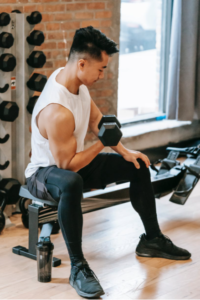 With COVID restrictions easing, people are returning to their favorite sports with enthusiasm and sometimes wild abandon. The tennis players are competing with the pickle ball players for access to courts. Surfing breaks are crowded, hiking trails and national parks are packed with people. There are lines of cars waiting for parking at many gyms, sports fields, and beach parks.
With COVID restrictions easing, people are returning to their favorite sports with enthusiasm and sometimes wild abandon. The tennis players are competing with the pickle ball players for access to courts. Surfing breaks are crowded, hiking trails and national parks are packed with people. There are lines of cars waiting for parking at many gyms, sports fields, and beach parks.